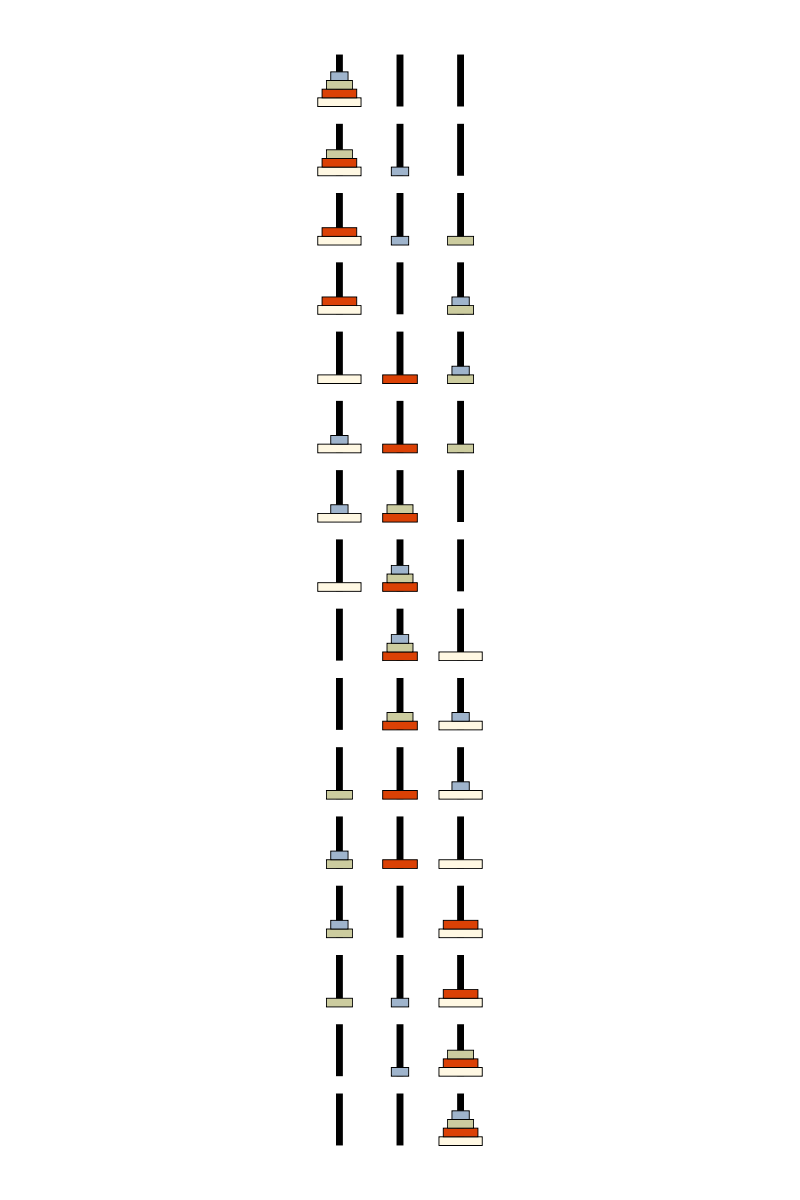Visual solution to the classic Towers of Hanoi puzzle.

import Diagrams.Backend.SVG.CmdLine{-# LANGUAGE NoMonomorphismRestriction #-}
import Diagrams.Prelude
import Data.List
import Data.Colour.SRGB (sRGB24read)
type Dia = Diagram BFirst, some colors for our disks, and types to represent the data structures involved.
colors = cycle $ map sRGB24read [ "#9FB4CC", "#CCCC9F", "#DB4105", "#FFF8E3", "#33332D"]
type Disk = Int
type Stack = [Disk]
type Hanoi = [Stack]
type Move = (Int,Int)To render a single disk, draw a rectangle with width proportional to
its disk number, using a color selected from the colors list.
renderDisk :: Disk -> Dia
renderDisk n = rect (fromIntegral n + 2) 1
# lc black
# lw thin
# fc (colors !! n)To render a stack of disks, just stack their renderings on top of a
drawing of a peg. We use alignB to place stack of disks at the
bottom of the peg.
renderStack :: Stack -> Dia
renderStack s = disks `atop` post
where disks = (vcat . map renderDisk $ s)
# alignB
post = rect 0.8 6
# lw none
# fc black
# alignBFinally, to render a collection of stacks, lay them out
horizontally, using the Distrib method so the pegs end up spaced
evenly no matter the width of the disks on any particular peg.
renderHanoi :: Hanoi -> Dia
renderHanoi = hcat' (with & catMethod .~ Distrib & sep .~ 7) . map renderStackNow some code to actually solve the puzzle, generating a list of moves which are then used to simulate the solution and generate a list of configurations.
solveHanoi :: Int -> [Move]
solveHanoi n = solveHanoi' n 0 1 2
where solveHanoi' 0 _ _ _ = []
solveHanoi' n a b c = solveHanoi' (n-1) a c b ++ [(a,c)]
++ solveHanoi' (n-1) b a c
doMove :: Move -> Hanoi -> Hanoi
doMove (x,y) h = h''
where (d,h') = removeDisk x h
h'' = addDisk y d h'
removeDisk x h = (head (h!!x), modList x tail h)
addDisk y d = modList y (d:)
modList i f l = let (xs,(y:ys)) = splitAt i l in xs ++ (f y : ys)
hanoiSequence :: Int -> [Hanoi]
hanoiSequence n = scanl (flip ($)) [[0..n-1], [], []] (map doMove (solveHanoi n))Finally, we render a sequence of configurations representing a solution by laying them out vertically.
renderHanoiSeq :: [Hanoi] -> Dia
renderHanoiSeq = vcat' (with & sep .~2) . map renderHanoi
example = pad 1.1 $ renderHanoiSeq (hanoiSequence 4) # centerXYmain = mainWith (example :: Diagram B)